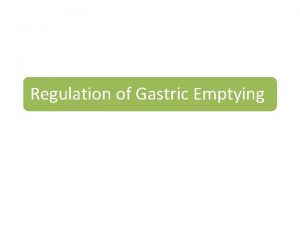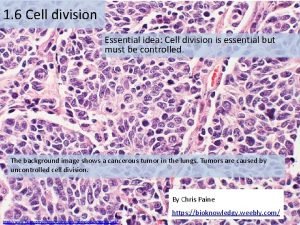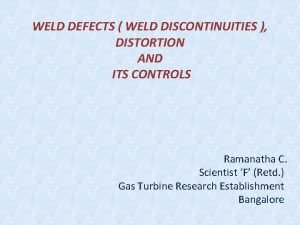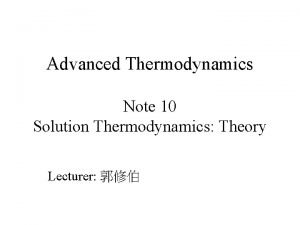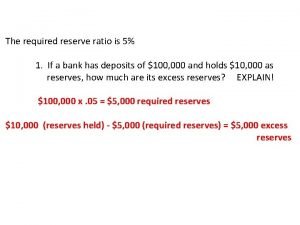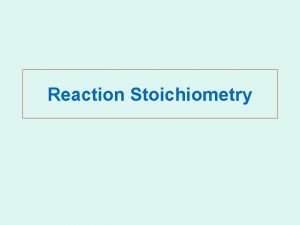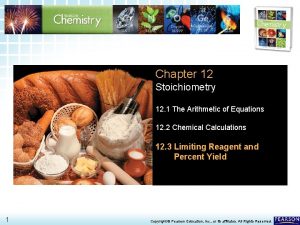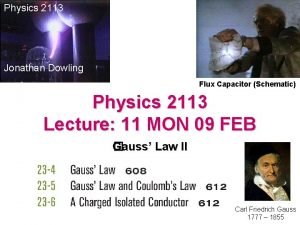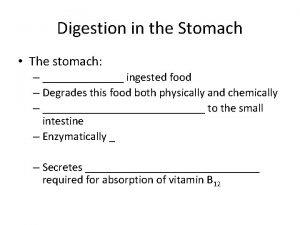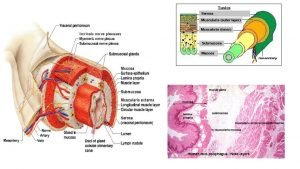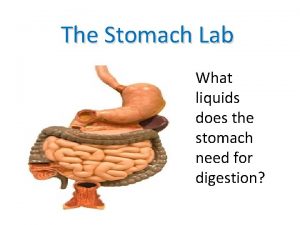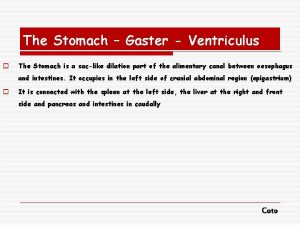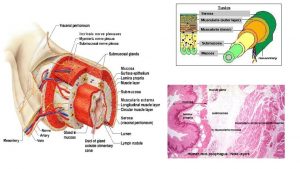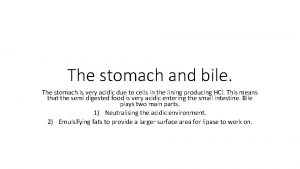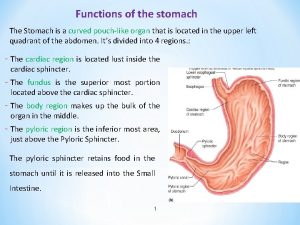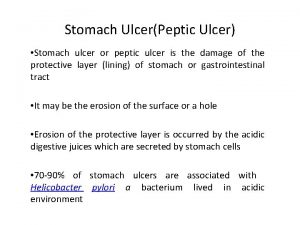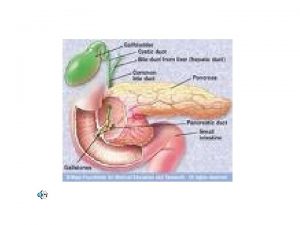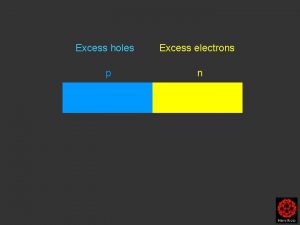p H regulation in stomach Essential idea Excess






















- Slides: 22

p. H regulation in stomach Essential idea Excess stomach acid is a common problem that can be alleviated by compounds that increase the stomach p. H by neutralizing (1) or reducing its secretion (2).

p. H regulation in stomach • What p. H? • Why? • Where does it come from? • What is the problem?

Acid in stomach The acid in the stomach is needed to: • Kill any bacteria that were ingested with the food. • Provide the optimum p. H environment (between p. H 1. 0 and 2. 0) for the digestive enzymes that act in the stomach (different parts of the digestive tract needs a different p. H environment)

Excess acid in stomach • Dyspepsia = conditions that cause pain and discomfort in the upper digestive tract such as the stomach e. g. heartburn and indigestion. • Acid indigestion = discomfort/pain in stomach. • Heartburn = acid from the stomach rising into oesophagus- reflux- that causes inflammation in the oesophagus. • Both are conditions that arise when excess hydrochloric acid is produced by parietal cells in the gastric glands in the walls of the stomach making the gastric juice too acidic as it can have a p. H of less than 1. • Ulceration: damage to the stomach wall

Solution Dyspepsia can be prevented either by: • Regulate p. H by reducing the effect of excess acid after it has been released in the stomach by using medicines called antacids to neutralize some of the excess acid. • Preventing the production of the excess acid by using medicines called H 2 –receptor antagonists or proton pump inhibitors.

Action of antacids • Antacids are usually weak bases that are used to neutralize excess hydrochloric acid in the stomach so the p. H level returns to the desired level i. e. p. H 1. 0 to 2. 0. • Al(OH)3 (s) Mg(OH)2 (s) Na. HCO 3(s) Na 2 CO 3 (s) Mg. CO 3(s) and Al(OH)2 Na. CO 3(s) are commonly used as active ingredients in such antacids as they are weak bases.

Action of antacids • Antacids containing Al 3+ are the most effective antacids as they have 3 hydroxide/base ions per formula unit and can therefore neutralize three times as many H+ than for instance sodium hydrogen carbonate. • Sodium hydroxide or potassium hydroxide are not used as antacids because they are strong alkalis and are too corrosive to the body tissue.

Antacid equations Write balanced symbol equations of the reaction with HCl (aq) for all the listed antacids: • Al(OH)3 (s) • Mg(OH)2 (s) • Na. HCO 3(s) • Na 2 CO 3 (s) • Mg. CO 3(s) • Al(OH)2 Na. CO 3 (s)

Balanced equations - answers • • • Al(OH)3 (s) + 3 HCl (aq) Al. Cl 3 (aq) + 3 H 2 O (l) Mg(OH)2 (s) + 2 HCl (aq) Mg. Cl 2 (aq) + 2 H 2 O (l) Na. HCO 3(s) + HCl (aq) Na. Cl (aq) + H 2 O (l) + CO 2(g) Na 2 CO 3 (s) + 2 HCl (aq) 2 Na. Cl (aq) + H 2 O (l) + CO 2(g) Mg. CO 3(s) + 2 HCl (aq) Mg. Cl 2 (aq) + H 2 O (l) + CO 2(g) Al(OH)2 Na. CO 3(s) + 4 HCl (aq) Al. Cl 3 (aq) + Na. Cl (aq) + 3 H 2 O (l) + CO 2(g) Ionic equations: • OH- (aq) + H+ (aq) H 2 O (l) • CO 32 - (aq) + 2 H+ (aq) H 2 O (l) + CO 2(g) • HCO 3 + H+ H 2 O (l) + CO 2(g)

Alginates • Some antacids contain compounds called ‘alginates’ which prevent heartburn by producing a neutralizing layer on top of stomach contents and • preventing acid in the stomach from rising into the oesophagus (refluxing) and causing heartburn (inflammation and pain).

Anti-foaming agents Antacids that use carbonates also contain anti-foaming agents such as dimethicone which reduce the bloating of the stomach as a result of the carbon dioxide production.

Calculations of the p. H of a buffer Buffering systems exists in the human body to regulate the p. H in various environments including cells. What are buffering systems and how do they do it? Henderson-Hasselbalch equation + excercises

Buffer calculation

Buffer calculation answer

Reducing the secretion of the acid (1) H 2 -receptor antagonists Production of HCl involves hormones (such as histamine) that interact with H 2 -receptors in the parietal cells in the gastric glands and this stimulates the production of HCl that is released in the lumen of the stomach. Drugs called H 2 -receptor antagonists, such as ranitidine (Zantac), can be used to prevent the histamine from interacting with the H 2 -receptor and therefore inhibiting acid production. As the drug has a similar structure to the histamine, it competes with histamine to interact and bind with the H 2 -receptors preventing the histamine from doing so

H 2 -receptor antagonists

Reducing the secretion of the acid (2) Proton pump inhibitors • After the acid has been produced its secretion into the stomach involves a transfer of H+ ions (protons) into the lumen of the stomach and this is balanced out by a movement of K+ in the opposite direction to balance the charges in the lumen. • The H+ ions are transferred or pumped into the lumen by the parietal cells; these cells are therefore referred to as proton pumps. • This proton pumping process requires energy as it goes against concentration gradient) that is provided by the hydrolysis of ATP and this requires an enzyme referred to as H+/K+ ATPase or a gastric proton pump. • Compounds such omeprazole (Prilosec) and esomeprazole (Nexium) inhibit the action of the enzyme and therefore the release of the acid into the stomach.

Proton pump inhibitors

Reducing the secretion of the acid (3)

In summary Symptoms of acid indigestion and heartburn can be relieved by increasing the p. H of the stomach by either: • Reducing the effect of the excess acid after it has been released in the stomach by using antacids to neutralize some of the excess acid. Antacids have an immediate effect but only last for a short-term. • Preventing the production of the excess acid in the first place by using H 2 –receptor antagonists or proton pump inhibitors. Both the H 2 –receptor antagonists and proton pump inhibitors take a longer time to provide relief but have a longer term effect; they can also be used to treat ulcers.

Active metabolite An active metabolite is an active form of a drug that has been administered in an inactive form because of a number of reasons. The inactive form is then metabolized by the body into its active form (bioactivated) that has a greater therapeutic effect than the inactive form. Possible reasons for using an inactive form include: • Has greater bioavailability because it is more soluble or is absorbed faster. • Easier to administer. • More selective in its interaction with healthy cells. • Has fewer side effects linked to the administration. • Can be stored longer. • Can withstand different storage conditions.

Example of an active metabolite • An example where active metabolites are used are the proton pump inhibitors esomeprazole and omeprazole. • They are administered in their inactive form as it allows the drugs to, once in the body, easily cross the cell membranes of the parietal cells (giving the drug a higher bioavailability). • In the inactive form they cannot interact with the gastric proton pump. • However, the hydrochloric acid in the parietal cells causes both the esomeprazole and omeprazole to change from its inactive into an active form that can interact with the gastric proton pump and inhibit its action.
 What is pyloric pump
What is pyloric pump Essential non essential fatty acids
Essential non essential fatty acids Mitosis and cell cycle terminology
Mitosis and cell cycle terminology Distinguishing theme from central idea
Distinguishing theme from central idea Supporting sentence 2
Supporting sentence 2 Homiletical idea
Homiletical idea Stated main idea
Stated main idea What is controlling idea
What is controlling idea Penanda wacana persoalan
Penanda wacana persoalan Idea subject
Idea subject Excess return
Excess return Underfill welding definition
Underfill welding definition Hagma causes
Hagma causes Solution thermodynamics theory
Solution thermodynamics theory Excess 4 notation
Excess 4 notation Required reserve ratio
Required reserve ratio Jettison excess baggage
Jettison excess baggage Excess heat reduce
Excess heat reduce What is the limiting reactant
What is the limiting reactant Limiting reactant definition
Limiting reactant definition Limiting reactant examples
Limiting reactant examples Limiting reagent and excess reagent
Limiting reagent and excess reagent Excess charge
Excess charge
